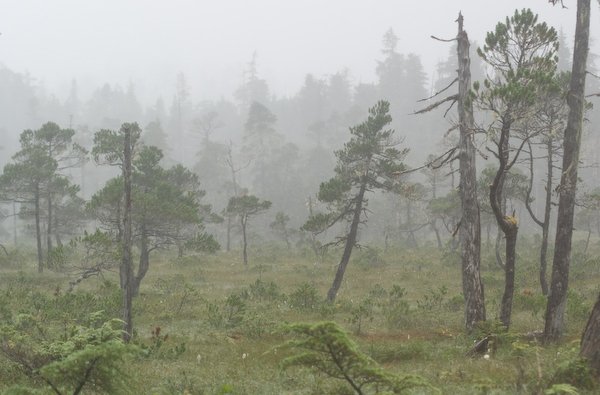My brother and I went for a hike up Indian River valley today. He wanted to look for evidence of bear activities such as sign trees and bedding areas. The most easily accessible place where I’ve seen anything like this is in the muskegs below the middle sister, so we chose that for our destination.
Weather: It was a very wet day. A fairly steady drizzle held for much of the hike, but the clouds thinned a little and the rain stopped around the time we started back. There was a bit of a breeze in the valley, but not too strong.
Birds: There were several Brown Creepers in a loose group along the trail. I’m guessing maybe they were family, but I don’t know for sure. They were the first creepers I have seen in months.
In the woods between the two muskegs, I heard a strange buzzing type call. I thought it might be a juvenile bird, but despite a couple of attempts to locate it, I was unable to do so. There was an adult Lincoln’s Sparrow hanging around chirping at me, so I think maybe it had a nest around.
While I was watching and looking for the mystery juvenile, I saw a Wilson’s Warbler fly through foraging in the bursh.
There was a bird scat on a small hummock in a muskeg that I noticed but didn’t give a second glance. Jonathan stopped and looked at it a little more closely and said it was from a Northern Flicker. He said it was the right size/shape and it was full of ants, so there were not really many other options. A little later I heard a flicker calling in the distance.
Flora: Most of the flowers were past their prime, the primary exceptions were the Swamp and Broad-petalled Gentians. A couple of different species of orchids were at the end of their blooming.
Small twistedstalk had berries.
The dwarf blueberries were ripe in the muskegs. There were some faily extensive patches of them, and though the berries were not especially abundant, they tasted good.
The fungi are out. There were many different species that I saw, but I didn’t stop to take a close look at most of them. Of particular note were two different puffballs that I noticed. I had never noticed puffballs around here previously. Maybe I should get out and do more fungi walks with my tripod, so I can get better photos.
Tracking: We stopped quite a few places for Jonathan to take a look at tracks. We saw several bear, deer, dog, and human tracks in various sandy locations on the way up, but the best location was a bit of sand in a wash that was protected from the falling rain by a log. Under this log was a set of small weasel family. They were probably mink tracks, but were a little small for that. Also in this place he found some bird tracks (probably from a thrush).
Also on the way up was a rotting stump that had been excavated. We suspect it was a bear, but there was little conclusive evidence (though Jonathan did find a couple of hairs). It’s unclear why a bear would have done this, unless it was chasing something, but I don’t know what.
We were partially successful in our quest to find bear sign. We did find several trees that bears had used as sign trees. In addition the damage from rubbing, scraping, and biting, there was hair on these trees. The hot foot trails we already knew about, but this time I paced off the longer one. Based on a (conservative) guess at my pace and the number of steps, I think the trail was at least 500-600 feet long. It starts in the muskeg at the upper end and follows near one side of the muskeg about halfway down before turning abruptly and going into the woods. At this point the obvious foot prints end until the trail comes out in the upper muskeg a short distance away and up a small rise. The foot prints start there again, but end pretty quickly. Along the way, there were at least two different sign trees.
Jonathan also took a close look at some bear scat in the muskeg. It was clear the bear had been eating blueberries and it also looked like skunk cabbage remains. What was a little more surprising were the seeds from Cow Parsnip. I would not have guessed that bears ate those, but I do not know what else they would have been.
Other Notes: Though we took a quick look on the way up, we did not notice any pink salmon in the river where we could see it from the trail (somewhat beyond the muskeg). On the way back, we saw several salmon up almost as far as the pools by the sculpted rocks where the water survey equipment used to be. I suspect the rain raised the water level in the river and encouraged the salmon to move up further.
The millipedes here really seem to like mushrooms. One of the mushroom clusters I photographed was just packed with millipedes. As this particular cluster was on an alder log that I believe was somewhat elevated, I’m curious as to how these millipedes manage to find the mushrooms when the route would necessarily not be all that direct.

I love the photo! That really captures the day and the place.
Carolyn H.
http://www.roundtoprumings.blogspot.com
I agree – I love the photo too. It makes me kind of homesick.
Thanks for the comments. It was definitely one of those days in Southeast Alaska. My brother and I seem to pick the wetest of days to visit this place.